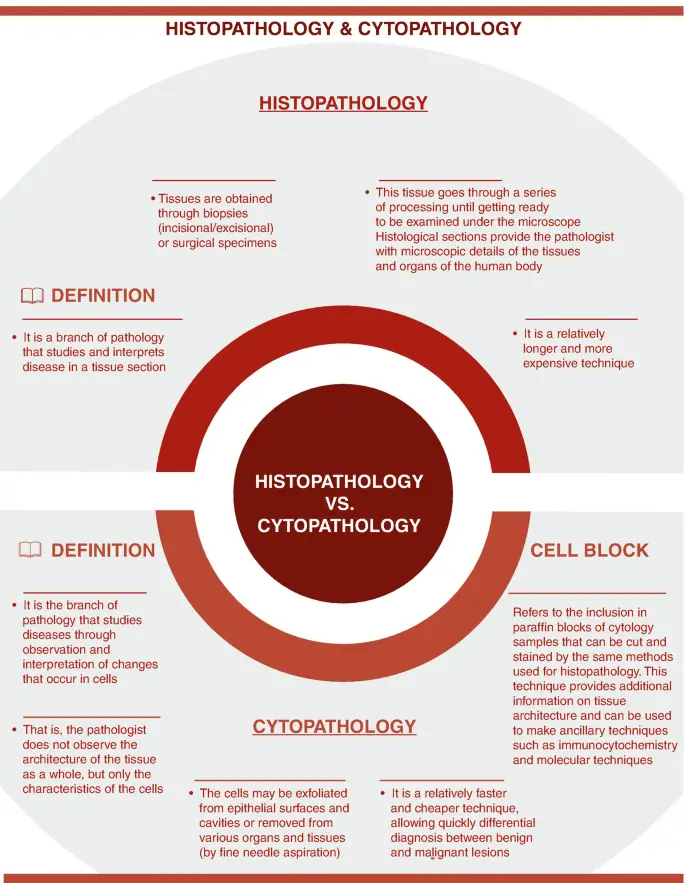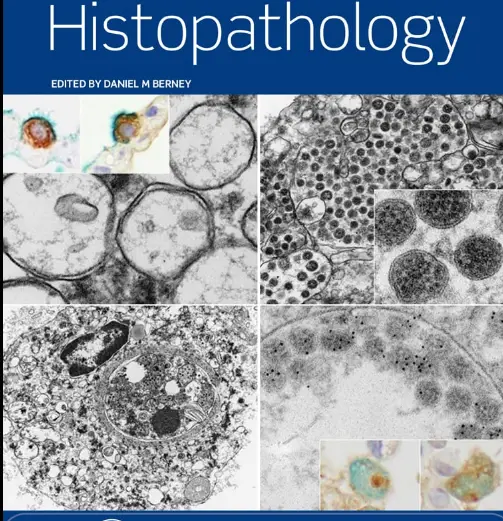Histopathology and cytology are two fundamental pillars within the realm of medical diagnostics, each playing a pivotal role in detecting and managing various diseases. While they share the common goal of identifying pathological conditions, their approaches and utilities differ significantly. This distinction is crucial for medical professionals when deciding the appropriate diagnostic technique for specific clinical situations.
Histopathology involves the microscopic examination of tissue biopsies to detect abnormal conditions, primarily diseases such as cancer. It provides a detailed architecture of tissue samples, allowing for comprehensive analysis and diagnosis. On the other hand, cytology focuses on the study of individual cell changes, often used for rapid and less invasive screenings, notably in the detection of cancerous and precancerous cells in fluids or smears.
The choice between histopathology and cytology often depends on the nature of the disease suspected, the required precision of the diagnosis, and the available tissue or sample. Histopathology is indispensable for a detailed tissue diagnosis and is often definitive, while cytology is preferred for quick, initial assessments or where less invasive methods are required. Understanding the capabilities and limitations of each can significantly impact patient outcomes, making their differentiation a critical component of medical education and practice.

Defining Histopathology
What is Histopathology?
Histopathology is the science of diagnosing diseases by examining the microscopic structure of tissues. This branch of pathology is crucial for understanding the context of diseases within body tissues, such as identifying changes linked to diseases like cancer.
Key Techniques Used
Several techniques are pivotal in histopathology:
- Fixation: Preserves tissues immediately after removal to prevent decay.
- Sectioning: Thin slices of tissue are cut to allow for detailed microscopic examination.
- Staining: Chemicals are used to color tissue components, enhancing contrast under a microscope.
These techniques collectively help pathologists to observe fine details that are not visible to the naked eye.
Applications in Medicine
Histopathology is extensively used across various medical fields. Its applications include:
- Diagnosis of Cancer: By examining tissue biopsies, pathologists can identify cancerous cells and determine the exact type and stage of cancer.
- Inflammation and Infection Detection: Helps in identifying patterns of inflammation and detecting infectious organisms in tissue samples.
- Autoimmune Diseases: Critical for diagnosing diseases where the body’s immune response attacks its own tissues.
Exploring Cytology
Definition of Cytology
Cytology, often referred to as cell biology, involves the study of cells in terms of structure, function, and chemistry. It’s widely used for medical diagnosis, especially in tests like the Pap smear.
Core Techniques
Key cytological techniques include:
- FNA (Fine Needle Aspiration): A thin needle is used to collect cells from lumps or masses.
- Exfoliative Cytology: Cells that naturally shed or are scraped from tissues are examined, such as in Pap smears.
Role in Diagnostic Processes
Cytology plays a significant role in:
- Cancer Screening: Particularly effective for early detection of cancers such as cervical cancer.
- Infectious Diseases: Helps in identifying pathogens in body fluid samples.
- Inflammatory Diseases: Can be used to detect causes of inflammation in body fluids.
Comparative Analysis
Sample Collection Differences
- Histopathology: Requires tissue biopsies, often necessitating surgery or invasive procedures.
- Cytology: Generally involves less invasive methods like swabs or fine-needle aspirations.
Processing Techniques
- Histopathology: Involves complex processing including paraffin embedding, which takes longer but provides detailed results.
- Cytology: Quicker preparation and staining of slides, suitable for rapid assessment.
Analysis and Interpretation
- Histopathology: Provides a comprehensive view of tissue architecture, crucial for many diagnostic processes.
- Cytology: Focuses on cellular abnormalities, useful for initial screening and quick diagnoses.
Advantages of Histopathology
Detail and Accuracy
The detailed tissue analysis possible with histopathology offers high diagnostic accuracy, essential in complex cases where precise tissue architecture examination is necessary.
Use Cases in Disease Diagnosis
Histopathology is indispensable in:
- Complex Cancer Diagnoses: Where detailed tissue architecture is necessary to determine the type and stage of cancer.
- Chronic Diseases: Offers insights into long-term diseases affecting tissue structures.
- Forensic Pathology: Essential for determining causes of death and other forensic investigations.

Benefits of Cytology
Speed and Efficiency
Cytology is recognized for its rapid turnaround times, which is crucial in clinical settings where quick diagnosis can lead to early treatment and better patient outcomes. Techniques such as the Pap smear or fine needle aspiration (FNA) yield results significantly faster than traditional histopathological methods. This speed is particularly advantageous in screening programs and preliminary assessments.
Non-invasive Approach
Another key advantage of cytology is its non-invasive nature. Many cytological procedures, such as fluid aspirations and brush biopsies, require minimal to no surgical intervention. This reduces the risk associated with the procedure, lowers the cost, and is generally more acceptable to patients.
Challenges and Limitations
Histopathology Challenges
While histopathology offers detailed diagnostic information, it faces several challenges:
- Invasiveness: Requires tissue removal, which might not always be feasible.
- Time-Consuming: The preparation of slides for viewing under a microscope can be lengthy.
- Cost: Generally more expensive due to the intricate processing and skilled personnel required.
Cytology Limitations
Cytology, while faster and less invasive, also has limitations:
- Less Detail: Cannot provide the same level of structural detail as histopathology, which may lead to missed diagnoses.
- Dependent on Sampler Skill: The accuracy can greatly depend on the skill of the person obtaining the sample.

Technological Advances
Innovations in Histopathology
Recent technological advances have greatly enhanced the capabilities of histopathology:
- Digital Pathology: Utilizes digital platforms for slide scanning, allowing remote diagnostics and easier access to second opinions.
- Automated Staining Techniques: Improve the consistency and speed of tissue sample preparation.
Cytology Enhancements
In cytology, technology has also made significant strides:
- Liquid-Based Cytology: Enhances the quality of samples by reducing debris and providing clearer cell samples.
- Molecular Cytology: Introduces the use of molecular markers to improve the specificity of diagnoses.
Practical Applications
Cancer Diagnosis
Both histopathology and cytology are indispensable in the diagnosis of cancer. Histopathology can detail the architecture of a tumor, while cytology is often used for initial screenings or to monitor treatment efficacy.
Infectious Diseases
Cytology is particularly useful in the diagnosis of infectious diseases where pathogens can be quickly detected in fluid samples. This rapid identification can be crucial in preventing the spread of infectious diseases.
Screening Programs
Cytology is the cornerstone of various screening programs, most notably in cervical cancer through the use of Pap tests. These programs have been successful in early detection and have markedly reduced mortality rates.
Future Prospects
Emerging Trends in Pathology
The field of pathology is currently experiencing a shift towards more integrated diagnostic approaches, combining histopathological techniques with molecular and genetic testing. This integration aims to enhance diagnostic accuracy and tailor treatments more effectively.
Research and Development Focus
Ongoing research and development are focused on enhancing both histopathology and cytology techniques through AI and machine learning. These technologies aim to improve diagnostic accuracy, reduce human error, and expedite processing times.
Frequently Asked Questions
What is Histopathology?
Histopathology refers to the examination of a biopsy or surgical specimen by a pathologist, after the specimen has been processed and histological sections have been placed onto glass slides. This method provides detailed insights into the tissue architecture that can be crucial for diagnosing diseases and planning treatment.
How does Cytology differ from Histopathology?
Unlike histopathology, which involves examining whole sections of tissues, cytology involves the study of individual cellular elements. It is often used for quicker, less invasive tests like Pap smears, where cells are examined for pre-cancerous or cancerous changes.
When is Cytology preferred over Histopathology?
Cytology is typically preferred in scenarios requiring a rapid diagnosis or when a non-invasive method is ideal. It is commonly used in routine screenings such as those for cervical cancer, where early detection of potentially precancerous cells is possible through simple smear tests.
What are the limitations of Histopathology?
While histopathology provides comprehensive details about tissue architecture, it is more invasive, often requiring surgical intervention to collect tissue. Additionally, it can be more time-consuming compared to cytology, delaying diagnosis in urgent cases.
Can Cytology diagnose all types of cancers?
Cytology is effective for diagnosing certain types of cancers, particularly those that shed cells into bodily fluids or that can be sampled via superficial scrapings. However, it is not suitable for all cancer types, especially those involving solid tumors where deeper tissue analysis is necessary.
Conclusion
The utilization of histopathology and cytology in medical diagnostics represents a critical aspect of patient care, guiding the treatment of myriad diseases. While histopathology offers detailed, architectural insights into tissue samples, cytology provides a quicker, often less invasive approach to cellular analysis. Both methods are indispensable, yet their application depends on specific clinical scenarios, highlighting the importance of an informed choice in diagnostic techniques.
As medical technology advances, the precision and capabilities of both histopathology and cytology continue to evolve. Understanding their distinct roles not only enhances diagnostic accuracy but also ensures better patient management, affirming their vital place in modern medicine.

